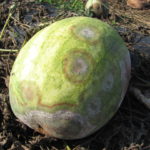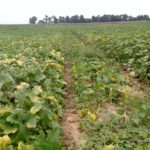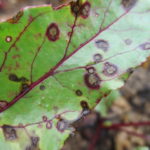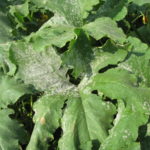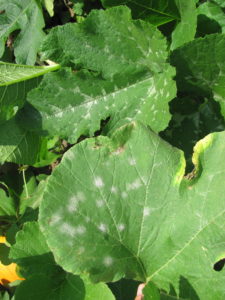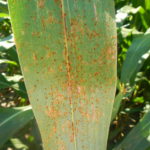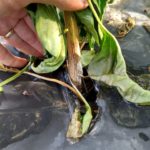The Midwest Vegetable Production Guide for Commercial Growers 2018 described above is a good way to keep up with what fungicides are recommended and their proper use. Last year, I developed a fungicide schedule to help growers schedule when fungicides are applied. These fungicide schedules seemed to be popular, so I have updated the fungicide[Read More…]
The Midwest Vegetable Production Guide for Commercial Growers 2018 is available for sale as a hardcopy ($15) or free on-line. Actually, the Vegetable Guide has been available since last December. The guide may be purchased through the Education Store, at various extension meetings held around the state or from your Purdue University county educator. The[Read More…]
This disease was a serious problem in much of the state this past summer. As a result, I have had many questions about managing this disease. The questions I have been asked have ranged from what do I spray to how does this disease work? Therefore, I have written an article about the symptoms, biology and management[Read More…]
Earlier in August, downy mildew was reported on all cucurbit species in LaPorte County in northwest Indiana and on pumpkins in Starke County (just south of La Porte County). More recently, downy mildew was reported on cucumbers and butternut squash in Knox County in southwestern Indiana. In addition, downy mildew is strongly suspected on cucumbers[Read More…]
This time of year, I receive many complaints of pumpkin plants with yellow leaves. There can be many reasons why pumpkin plants have yellow leaves. The most common reason for yellow pumpkin leaves doesn’t have anything to do with a disease that can spread from plant to plant. Usually, the reason for the yellow pumpkin[Read More…]
This disease was observed in southern Indiana recently. Cercospora leaf spot affects table beets and swiss chard. Symptoms include circular leaf spots that may have a reddish margin. The center of the lesions may start off a light brown and turn to gray after the fungus (Cercospora beticola) begins to sporulate. Under conditions conducive to[Read More…]
Powdery mildew is a common disease of cantaloupe and pumpkin in Indiana. Occasionally, I observe this disease on watermelon as well. Recently, I have noticed more powdery mildew than usual on watermelon. If left uncontrolled, this disease can cause loss of foliage, loss of yield and lower quality fruit. This article will discuss the biology[Read More…]
One of the most common diseases of pumpkin in Indiana is powdery mildew. Growers are naturally anxious to observe whether the fungicide they have been applying for this disease has been effective. Therefore, many pumpkin growers scout their fields for disease. Although powdery mildew is relatively easy to recognize, it is possible to become confused. [Read More…]
Southern rust of corn is normally a disease of tropical areas. During summer months, however, the fungus which causes southern rust, Puccinia polysora, often moves into southern areas of the U.S. This summer, southern rust has been observed in at least 11 Indiana counties. Symptoms of southern rust include raised structures called pustules. If rubbed[Read More…]
Southern blight of pepper and tomato thrives under hot, dry conditions. Usually, such conditions are more likely in August. Production under tunnels may contribute to the dry conditions that influences southern blight. This article will discuss the symptoms, biology and management of southern blight of tomato. Southern blight has a wide host range affecting many vegetable,[Read More…]

